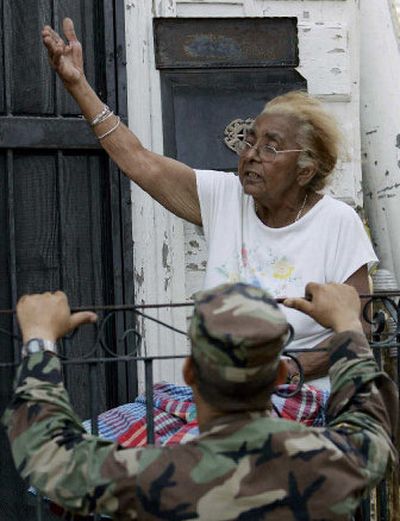Holdouts won’t budge

NEW ORLEANS – As floodwaters receded inch by inch Tuesday, New Orleans Mayor C. Ray Nagin authorized law enforcement officers and the U.S. military to force the evacuation of all residents who refuse to heed orders to leave the dark, dangerous city.
Nagin’s emergency declaration released late Tuesday targets those still in the city unless they have been designated by government officials as helping with the relief effort.
The move comes after some citizens bluntly told authorities who had come to deliver them from the flooded metropolis that they would not leave their homes and property. An estimated 10,000 residents are believed to still be in New Orleans, and some have been holed up in their homes for more than a week.
While acknowledging the emergency declaration, police Capt. Marlon Defillo said late Tuesday that forced removal of citizens had not yet begun. He said officers who were visiting homes were still reminding people that police may not be able to rescue them if they stay.
“That would be a P.R. nightmare for us,” Defillo said of any forced evacuations. “That’s an absolute last resort.”
Repeated telephone calls to Nagin’s spokeswoman, Tami Frazier, seeking comment were not returned.
Meanwhile, engineers struggled to drain the saucer of a city of billions of gallons of water, a Herculean task that could take weeks – if they are lucky.
The Army Corps of Engineers said the timetable ranges from three weeks to nearly three months, depending on a string of variables, including rainfall, the still-unknown condition of the pumps abandoned to Hurricane Katrina, and whether the system can withstand the flotsam of broken buildings, trees, trash and corpses.
Work has also been impeded by sporadic gunfire coming from “criminals with guns,” said Col. Richard Wagenaar, the corps’ chief district engineer.
The contractors are “getting used to it and that’s pretty scary,” Wagenaar said.
Despite complications, “we have to get the water out of the city or the nightmare will continue,” said Louisiana Environmental Secretary Mike McDaniel. He said the water will be pumped into Lake Pontchartrain even though it is fouled with sewage, heavy metals, gasoline and other dangerous substances.
The pumping began after the corps used hundreds of sandbags and rocks over the Labor Day weekend to close a 200-foot gap in the 17th Street Canal levee that burst in the aftermath of the storm and swamped 80 percent of this below sea-level city.
Following an aerial tour Tuesday, Nagin said the water was dropping ever so slightly, and he estimated that it covered only 60 percent of the city.
“Even in areas where the water was as high as the rooftops, I started to see parts of the buildings,” he said, adding, “I’m starting to see rays of light.”
But he also warned of the horrors that could be revealed when the waters recede. “It’s going to be awful and it’s going to wake the nation up again,” said Nagin, who a day earlier upped his estimate of the death toll in his city to as many as 10,000.
The job to rid the city of water got off to a woefully slow start.
Once all of the city’s pumping stations are running, they can move water at a rate of 29 billion gallons a day and lower the water level a half-inch per hour, or about a foot per day. But by late Tuesday afternoon, corps officials said only three of New Orleans’ normal contingent of 148 drainage pumps were operating.
With the water dropping, military and police turned their attention to evacuating the streets. Among those refusing to leave was 69-year-old John Ebanks, who waved off would-be rescuers from a porch stocked with food, mosquito spray and other supplies.
“You’ve got to protect your property, that’s the main thing,” Ebanks said. “This is all I’ve got. I’m pretty damn old to start over.”
In St. Bernard Parish, 38-year-old Dennis Rizzuto took a break from a Monopoly game with his family to emerge from the second-floor window of his home.
He said he had plenty of water, food to last a month and a generator powering his home. “They’re going to have to drag me” out, Rizzuto said.
In a plea to holdouts who might be listening to portable radios in the powerless city, Nagin warned that the fetid water could carry disease and that natural gas was leaking all over town.
“This is not a safe environment,” Nagin said. “I understand the spirit that’s basically, ‘I don’t want to abandon my city.’ It’s OK. Leave for a little while. Let us get you to a better place. Let us clean the city up.”
To that end, the Pentagon began sending 5,000 paratroopers from the Army’s storied 82nd Airborne Division to use small boats, including inflatable Zodiac craft, to launch a new search-and-rescue effort in flooded sections of the city.
Some National Guardsmen and helicopters were diverted from their search missions Tuesday to fight fires, an emerging threat in a city that is still at least a day and a half away from restoring the first running water since the storm.
A candle was blamed for starting one major blaze in the lower Garden District – a historic neighborhood of mostly wooden homes. The flames started in an abandoned brick building and spread to a neighboring apartment house. The blazes burned for hours before Chinook helicopters with water pouches were brought in to fight the blaze.
New Orleans Police Superintendent Eddie Compass said lawlessness in the city “has subsided tremendously,” and officers warned that those caught looting in an area where the governor has declared an emergency can get up to 15 years in prison. About 124 prisoners filled a downtown jail set up at the city’s train and bus terminal.
“We continue to get better day by day,” Compass said.